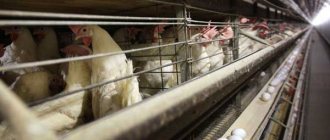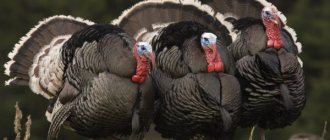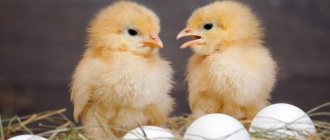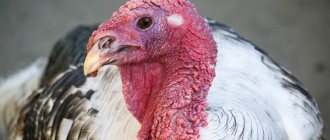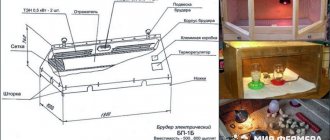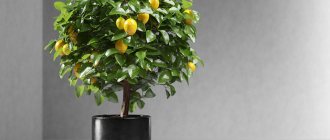Turkey breeding is a profitable and promising business that even inexperienced farmers can master. A little theoretical training, a small initial capital - and you can purchase young animals for fattening. If you approach the matter wisely, turkeys will provide you with a stable income.
Features of the bird
Turkeys differ from other poultry:
- quarrelsome disposition;
- gluttony - they eat a lot, but their meat productivity is enviable;
- strict hierarchy - only one, the most important turkey, has the right to fertilize females;
- slow growth - reach marketable weight in 6 months, and broiler crosses - in 3 months;
- low egg production - turkeys lay about 120 eggs per year.
Differences between males and females
The sex of a chick can be determined at one day of age. Males have evenly shaped wings because the feathers are the same length. Then this sign disappears, and then it will be possible to distinguish between “boys” and “girls” at two months.
Differences between males and females:
- Male turkeys have a characteristic nasal process. It is located on the head and hangs down to the chest. The growths on the nose look like large, fleshy warts.
- The male has no feathers on his head at all.
- Males are almost twice as heavy as females.
- Males have stiffer chest feathers and are interspersed with tassels. Turkeys have down so soft that they stuff pillows with it.
- The legs of males are decorated with spurs.
Features of oviposition
The egg production of turkeys is affected by their age, physical condition and living conditions. Turkeys reach their peak egg production at one year of age. In the second year, egg production drops by 30-40%. For laying eggs, farmers usually select the most physically strong one-and-a-half-year-old turkeys.
Turkeys lay eggs for a brood in the spring - at the end of March or beginning of April. Therefore, before the onset of spring, it is necessary to select females of the appropriate age.
How much do turkeys weigh?
The weight of turkeys varies widely - from 10 to 35 kg. Poultry farmers distinguish three classes of turkeys:
- heavyweights;
- average;
- lungs.
The maximum weight of turkeys is 10-15 kg.
Advantages and disadvantages of breeding
The egg-laying abilities of turkeys are in the background. The main purpose of breeding this bird is tasty dietary meat. And in large quantities, since turkey carcasses are much heavier than those of other poultry.
When the time comes for slaughter - after 6 months of cultivation, the carcass contains 80% of valuable dietary meat, which in many respects is more valuable than rabbit and chicken.
When breeding turkeys, the largest investments are associated with the purchase of eggs, incubation and the first month of life of the chicks. Further, costs are reduced by switching to more affordable feed. The advantages of breeding turkeys are obvious:
- Obtaining valuable dietary meat with excellent taste. Turkey meat is in demand.
- Breeding costs quickly pay off.
- In addition to meat, down and feathers can be sold.
- Quick gain of meat mass.
- Unpretentiousness to living conditions and food.
Turkeys were domesticated on the American continent about a thousand years ago, and they were brought to Europe in the 16th century.
Disadvantages of turkey breeding, due to which many people give up a profitable business:
- low egg production;
- high risk of chick death;
- demands on water - you must use only fresh water heated to room temperature;
- tendency to illness if the rules of hygiene and sanitation during care are violated;
- Turkeys are prone to obesity.
Plucking
In order to properly pluck the carcass and remove all the flight feathers, it is doused with hot water. The water temperature should not exceed 65 °C, and the carcass should remain in the water for no more than a minute. Immediately after removal from the water, plucking begins. This must be done quickly so that the pores do not have time to close, in which case the flight feathers are very difficult to remove.
You can remove a pen in the following ways:
- dry;
- wet;
- when using an iron;
- use of a special nozzle.
The dry method involves plucking after slaughter, which will prolong the preservation of the meat. Large flight and tail feathers, which are first scalded with boiling water, are especially easily removed.
An interesting way of plucking is using paraffin. To do this, heat the paraffin in a high container and dip the bird into the vessel. Keep the turkey in the paraffin for a few seconds and then let it harden. In this case, the quality of processing will be better than if you use only water.
An iron is also used if you need to get a feather. The method may seem somehow special, but it is widely used in many farms. To do everything correctly, you will need the following things:
- iron with steam function;
- pump;
- gauze or fabric 70x70 cm;
- a bowl filled with cold water;
- rope.
The feather is removed according to the following scheme. The pump is inserted under the skin in the neck area and begins to pump air until the feather melts. The main thing is not to overdo it, otherwise the skin will simply burst. To preserve air, the neck is tied.
Important! Plucking a turkey begins with the flight and tail feathers, adhering to the direction along their growth.
If the bird is cleared of feathers, the carcass is brought into the required form:
- At this stage, blood is removed from the mouth.
- Feet are washed.
- The carcass is wiped with a dry cloth and moved to the place for gutting.
Recommended Breeds
When the decision to breed turkeys is made, the first thing you need to do is choose a breed. The choice should be influenced, first of all, by the goals and conditions of detention, and only then by personal preferences. The most popular turkey breeds bred in Russia are shown in Table 1.
Table 1
| Breed | Description | Turkey weight, kg | Turkey weight, kg | Number of eggs per year |
| Bronze | Feathers are red and brown, with stripes. Males with black necks. They love walking and are unpretentious. | 13 | 7 | up to 100 |
| Moscow bronze | They are distinguished by increased endurance. Suitable for home and mass production. They love pasture walking. | 15 | 9 | 100 |
| Bronze broad-breasted | They are similar to the bronze breed - from which they originated, but have a larger body. Not suitable for walking, egg production is low. Most often used in industrial applications. | 14 | 8 | 70-80 |
| North Caucasian bronze | Bred in the USSR in 1946, this is one of the most popular domestic breeds. A large bird that adapts well to different conditions. | 14 | 7 | 80 |
| White broad-breasted | They are distinguished by a large chest and a wide back. Luxurious plumage and strong legs. | 15 | 7 | 100-120 |
| North Caucasian white | Hardy and productive breed. Fast weight gain. Feels good in pasture conditions. Unpretentious in matters of nutrition. | 13 | 7 | up to 180 |
Compound feed for large turkeys
Large turkeys grow quickly on mixed feed. At the same time, they rarely get sick, have tender meat and a beautiful color of the meat. But the main problem with such feeding is the price. Good feed is expensive, especially since turkeys need to purchase special feed designed for them. In the store, food for large turkeys is divided into types according to the weight and age of the bird. For example:
- PK-11 (“Starter”) – for newborns;
- PK-11-2 (“Starter”) – from 5 to 13 weeks;
- PC-12-1 – for weeks 14-17;
- PC-13-1 (sometimes called “Grower”) – 15-30 weeks;
- PK-14 – breeding young animals.
- Compound feed at the final stage of fattening is called “Finisher”. It is given to birds from 2 months until slaughter.
Indians are fed grain to gain weight quickly
As a rule, feed is purchased so that turkeys reach their maximum size in just one summer, while ideal conditions for pasture feeding are created outside. After about 4-5 months of feeding on compound feed, the turkey reaches normal weight for slaughter. But during this time he eats a lot of expensive food. So, for one female, 16 kg of feed is purchased for 4 months, and for a male, twice as much!
If after 4 months the turkey has not gained the required weight, it is fed for 2-3 weeks with nutritious flour food, consisting of:
- 25% wheat bran;
- 25% barley flour;
- 20% corn flour;
- 15% oat flour;
- 3% yeast;
- 1% salt.
Productivity and purpose
When breeding turkeys, depending on their goals, farmers are interested in productivity in two parameters:
- Egg production. Turkeys lay eggs from 8-10 months. Usually they lay 80-100 eggs, but the result can reach 180-200 eggs per year. There are 10-20 eggs in one clutch. Each is 60-70 g.
- Meat. Contains a lot of protein, vitamins and minerals. The net yield of meat depends on gender, the male gives 7-10 kg, the female - 3-6 kg.
To obtain a large number of eggs, egg breeds are chosen. There are broiler breeds that reach market weight by three months, but if left to lay eggs, they will lay 200 eggs a year. Such crosses include turkeys of the Canadian breed, Hidon and BIG-6. The most popular egg breeds are in Table 2.
table 2
| Breed | Peculiarities | Turkey weight, kg | Number of eggs per year |
| Virgin (Dutch) | love free range | 4-5 | 120-130 |
| Bronze | females are twice as light as males | to 10 | up to 100 |
| White Moscow | unpretentious, easily adapts to new conditions and sudden climate changes | 8 | up to 140 |
| Tikhoretskaya black | compared to other breeds - increased maternal instinct | 5 | 100 |
Special meat breeds are bred for meat - crosses, which are obtained through selection. The peculiarity of such breeds is weight gain in the shortest possible time. The bird is ready for slaughter at 3-5 months. For example, the Hidon cross weighs 9-10 kg already at 3 months. There is no point in keeping such heavy birds for longer than 6 months - if the mass increases further, there will be a load on the bones, they will begin to deform, and the bird will get sick. Popular meat breeds are in Table 3.
Table 3
| Breed | Peculiarities | Turkey weight, kg | Turkey weight, kg |
| White broad-breasted | relatively new breed, bred in America, unpretentious to keep | 17 | 8 |
| Hybrid Converter | has the highest weight to meat ratio – 85% | 22 | 12 |
Food for large turkeys
The daily feed requirement for a large, adult turkey is 500-800 g. In this case, it will grow quickly, gain muscle mass, but will not gain fat. It is impossible to say exactly how much and what a turkey should eat, but an approximate diet should include: grain, greens, fish, meat waste, meal, cake, flour mixtures, cottage cheese, milk.
Food for large turkeys should be varied
Cereals provide turkeys with up to 70% protein; minerals and vitamins are supplied with herbs and meat and fish waste (they are often replaced with meat and bone meal, meat and fish meal), and milk. Fiber, which is extremely necessary for adult birds, is provided through hay, straw, and other dry grasses. To make turkey meat tender and juicy, lard, acorns, vegetable oil and walnuts are required. But as an additive in small quantities.
Below is an approximate table of the daily diet of a large turkey.
| Feed | Turkey weight | ||
| 5-6 kg | 6-7 kg | 7 kg or more | |
| Grain meal (corn, oats, bran) | 250 | 300 | 350 |
| Wheat bran | 40 | 50 | 50 |
| Grain (corn, millet) | 70 | 70 | 80 |
| Carrots, sugar beets, rutabaga, pumpkin, turnips | 50 | 50 | 60 |
| Boiled potatoes | 100 | 100 | 120 |
| Meat, fish, food waste | 100 | 100 | 100 |
| Meat and bone meal | 10 | 10 | 15 |
| Salt | 2 | 3 | 3 |
What conditions are required for breeding and maintenance?
Turkeys are unpretentious to keep, and most importantly, they can withstand frosts down to -15°C without harm to their health. And yet, the most important requirements for breeding them are to provide them with a dry and warm room.
Premises requirements
When creating a comfortable poultry house, you need to consider the following points:
- For every two birds there should be at least 1 square meter. m area. Ideal conditions – 1 sq. m for each individual.
- The optimal summer temperature is 20°C; in winter, the room temperature should not fall below +5°C.
- To illuminate the poultry house, a regular 60 W electric lamp is suitable.
- There must be regular ventilation.
- Turkeys do not like dampness - there should always be dry bedding on the floor, which should be changed twice a week, at least.
- Each pen should have boxes with sand and ash - against parasites.
- There should be no drafts.
- Perches are equipped according to the number of birds - as many turkeys as there are perches. The distance between adjacent perches is at least 60 cm. The distance of the perch from the floor is 70-80 cm. The width of the perch is 5-7 cm, height is 8-10 cm.
In a pen of 5 females there should be one male so that all the hens are covered.
When breeding young animals, the maintenance requirements are increased:
- temperature not lower than 36°C;
- availability of constant lighting.
Turkey poults can spend the first days of life in a cardboard box or box. When the chicks mature, they are transferred to a common stall.
Walk
Walking has a positive effect on the physical condition and productivity of turkeys. Walking turkeys is necessary to prevent obesity. Here the bird looks for nutritious food - worms, beetles, plant seeds. The best place for walking is a dry area with grass and bushes.
If there is no free grazing, you need to equip a pen in the fresh air. The aviary is fenced with netting to protect the bird from predators. It is recommended to arrange the walk so that there is free movement between it and the poultry house - then the turkeys will move from indoors to outdoors on their own. Feeders and drinking bowls are equipped on the walk. Here you can spread the food directly on the ground.
Climate requirements
Temperature is the most important factor in the productivity of turkeys. If the room is cold, the food eaten is constantly used for warmth, and not for the formation of eggs or fat mass. At the same time, excessive heat also negatively affects egg production - the quality of the shell deteriorates and the weight of eggs decreases. For adult turkeys, the ideal temperature is 12-16°C; turkey poults need warmer conditions. Optimal temperatures for turkey poults depending on age are in Table 4.
Table 4
| Age | Optimal temperature, °C |
| up to 4 days | 22 |
| 5-20 day | 16-20 |
| up to 26 days | gradually normalizes and reaches 12 degrees |
How comfortable turkeys are in the created microclimate can be determined by their behavior.
- If the temperature is right, turkeys are active and eat and drink well. The birds are distributed evenly throughout the room.
- If the bird is cold, their feathers spread out - in this way they increase the protective air layer. Birds stay in a group - they warm themselves, and as a result, some individuals can be suffocated.
- If the room is hot, the birds breathe quickly, drink often and a lot, their beaks are open and their wings are spread out. The appetite is reduced or they do not want to eat at all.
Heat transfer is greatly affected by room humidity. When humidity is low, moisture evaporates quickly and the temperature rises. But if the humidity drops below 50%, the birds' mucous membranes become irritated, feathers break, and breathing becomes impaired. High humidity is also harmful - the litter becomes damp and mold appears.
Wintering turkeys
If the region does not have extremely low temperatures, a shelter or light plank structure will suffice for turkeys to overwinter. But in severe frosts, such conditions will not be enough. A reliable structure is both protection from frost and from predators who are especially active in looking for prey in winter.
Features of winter keeping turkeys:
- Temperature conditions. Turkeys can tolerate frosts down to -15°C - if they are short-term, but cannot tolerate dampness. Therefore, in cold weather it is recommended to maintain the temperature within minus 3-5 ° C, this will help avoid dampness in the room. If the litter is straw, it is changed at least once every 10 days, and sawdust and peat - once every 3 weeks.
- Lighting. If the poultry house where the young birds are kept is equipped with windows, you do not need to turn on the lighting. If there are no windows, the lights are turned on for 5-7 hours a day. For adult individuals, the light is turned on for 14 hours - otherwise there will be problems with oviposition and fertilization. To save energy, you can let birds outside on sunny days.
- Diet. In winter, the bird is fed three times a day. They give dry food in the mornings and evenings, and mash during the day. The winter diet is based on wheat, barley and corn. Be sure to provide succulent food in winter - grated carrots, beets, steamed alfalfa or clover. During the day you can also feed with ground chestnuts and acorns. They also provide branches of coniferous trees - they contain a lot of vitamin C and carotene. The needles are crushed and left in the trough for an hour, then added to the mash. To replenish vitamins, they also give rowan berries, dried nettles and dried birch leaves.
- Walks. Since turkeys have a tendency to obesity, they cannot do without walks. In normal weather, without extreme frosts, the walk lasts from 2 hours. The enclosure for walking is placed on the sunny side. The snow is first removed from the site - turkeys have very poor feet in the cold.
- Prevention. Birds spend a lot of time indoors in winter, so they can develop parasites. Indoors, during wintering, there must be boxes with crushed shells or charcoal, chalk.
Healthy food for turkeys
Vegetation is an integral part of bird nutrition
Food for large turkeys should be nutritious and healthy. If there are not enough vitamins and minerals in the diet, problems with bones and joints may begin, because carrying so much weight on yourself is not easy! Greens are the main source of all nutrients for poultry. Already from the 3rd day of life, chopped onions are introduced into the diet of turkey poults, and it is even more useful for an adult bird!
It is also important for turkeys to eat dandelions, clover, quinoa, wood lice, wormwood, duckweed, and pondweed. In addition to onions, garden crops that can be given include dill, cabbage, lettuce, parsley, arrows and garlic leaves.
To get a decent amount of meat from turkeys, broiler or cross-breed birds are bred. The young are characterized by rapid growth. It is sold for meat at 3-4 months. For fattening, it is recommended to use combined feeds or a balanced traditional diet.
For broilers, a certain feeding regime is maintained. It can be changed 2 weeks before slaughter to increase the muscle mass of turkeys. How to care for broilers? What to feed turkeys before slaughter?
Puberty and breeding
Turkeys become sexually mature when they reach 8-10 months. Turkeys begin laying eggs at 10 months. Many females sit on eggs, so you have to drive them away to pick up the clutch. Laying females need to be fed 5 times a day, and in winter add succulent food.
Natural breeding
After mating, the female is capable of laying up to 17 eggs. They are checked to see if they are fertilized or not. To make sure the eggs are fertilized, they are immersed in water one by one. Sinking eggs are fertilized and are placed in a nest or incubator. Those that have surfaced are not suitable for breeding turkey poults, but they can be used for food.
One hen turkey incubates and raises, in addition to her own offspring, other people's turkey chicks. She may have raised up to 80 turkey poults.
The hen incubates the eggs for 4 weeks. It is important that she receives food on time. You need to feed her in the morning. It is best to give her soaked oats. While the turkey is eating, the eggs need to be covered with something warm to prevent them from getting too cold.
Turkeys make excellent mothers; they hatch their offspring excellently, raise them, and protect them from any danger. In their worries, such mothers even forget to eat - you have to force them off the nest to feed them.
Hatchery breeding
Instead of hens, you can use an incubator. The eggs are promptly removed from under the turkey and put away for storage. In the incubator, eggs are placed with their sharp ends down. Hatching occurs approximately 28 days after the eggs are placed in the incubator.
For turkey chicks to hatch, you need to:
- for 22 days, turn the eggs 12 times a day - that is, every two hours;
- strictly observe the temperature regime.
The timing and temperature and humidity conditions of incubation are in Table 5.
Table 5
| Incubation period, days | Temperature, °C | Humidity, % | Number of turns |
| 1-7 | 38 | 65 | 6-12 |
| 8-14 | 38 | 50 | 6-12 |
| 15-25 | 37,5 | 65 | 4 times + 15 minutes cooling |
| 26-28 | 36,6 | 70 | No |
How to gut and pluck a turkey?
Having cut the turkey's belly with a knife, first the intestines are carefully removed, and the cloaca is cut out along with them. Next, you need to get the stomach, crop and liver, heart. A bird is distinguished as being completely gutted when the head is separated down to the second vertebra, the skin from the neck is removed down to the shoulders, and the paws are cut off at the knee joints. Only the lungs and kidneys will remain in the cavity.
The bird is not completely gutted if, after removing all the internal organs, the edible heart, washed stomach and liver are returned back to the belly. The neck is also added to them. Such a carcass does not retain freshness as well as a completely gutted one; it can remain in the refrigerator for up to 4 days.
Turkey meat is divided according to the degree of fatness, quality of gutting, and its grade is also influenced by age. The ideal option would be when the resulting carcass is a young bird with well-developed muscle mass, significant fat deposits under the skin, and with a minimum number of scratches and cuts.
Depending on the age of the turkey, the meat changes texture. When the bird already has a keratinized beak, long spurs, and the keel has already ossified, then it has already reached maturity and the product will be tougher and more fibrous. But it is suitable for food; it can make a wonderful aromatic broth or minced meat.
Feeding depending on age
The diet and frequency of feeding is determined by the age of the birds and the goals set - laying hens, young animals, and adults are fed differently. Let's look at a sample menu and nutritional standards for birds of different ages and purposes.
Feeding turkey poults
Chicks are fed frequently - this helps increase the survival rate of the young. During the first 6 days, turkey poults are fed at intervals of 2 hours. And at night too. And in order for the birds to show a desire to eat, the light in the enclosure must be turned on.
Gradually, the frequency of feedings is reduced, reaching 6 times a day - by this time the chicks are one month old. Two-month-old turkey poults are fed 4 times a day.
At first, the chicks are reluctant to eat, so you need to attract their attention:
- pouring feed in a thin stream;
- tapping on the feeder;
- sprinkling the food with chopped green onions and dandelion leaves.
Chicks up to a week old need 10 g of food per day. By the 30th week, the volume of food increases to 280 g, one-year-old individuals eat 400 g of food.
In the first days, the chicks should receive high-protein food (up to 22%). Feeding rates for turkey poults depending on age are in Table 6.
Table 6
| Feed, g | Day | ||||||||
| 1-5 | 6-10 | 11-20 | 21-30 | 31-40 | 41-50 | 51-60 | 61-90 | 91-100 | |
| corn | 5 | 8 | 20 | 25 | 45 | 55 | 77 | 112 | 145 |
| wheat bran | 5 | 5 | 6 | 10 | 11 | 12 | 13 | 14 | 25 |
| dry food of animal origin | — | 0,5 | 3 | 7 | 9 | 14 | 14,5 | 20 | 19 |
| fresh grass | 4 | 8 | 15 | 18 | 30 | 12 | 40 | 38 | 104 |
| return | 5-5,5 | 9 | 10 | 13 | 10 | — | — | — | — |
| low-fat cottage cheese | 1,5 | 10 | 9 | — | — | — | — | — | — |
| boiled eggs | 2-3 | 3-4 | — | — | — | — | — | — | — |
| shells | — | 0,5 | 0,7 | 1,5 | 2 | 2,5 | 2,3 | 2,1 | 2 |
| bone meal | — | — | 0,6 | 0,5 | 1 | 1,2 | 1 | 2,5 | 2,5 |
| table salt | — | — | — | — | — | 0,2 | 0,1 | 0,2 | 0,3-1,1 |
These are conditional feeding standards - it is not at all necessary to feed all the given foods at the same time. They can be interchanged, making the bird menu varied.
One-week-old turkey poults can be given greens and kitchen scraps. But gradually - so that there are no health problems. They also give mash.
Here is a basic mash recipe for 5-10 day old turkey poults:
- ground wheat grits – 35%;
- corn grits – 35%;
- wheat bran – 8%;
- chopped boiled eggs – 10%;
- fresh cottage cheese – 10%;
- shells and chalk – 2%.
Nutritional features depending on age:
- From 10 days of age, you can add ground nettle, clover and onion to the mash. Knead the mixture using skim milk or sour milk. They give mash around noon, and dry food in the evening. From 10 days, the chicks can also be released into the wild - onto the grass.
- From the age of one month, roughage and salt are included in the diet. By this time, the chicks’ digestive system has already become stronger and will not reject roughage.
- From the age of two months, you can give a complete diet to adult birds, but in a softened version - grated, ground, crushed.
- At three months you can give turkey poults bran and ground corn. When switching to a 4-meal diet, the bird is given grain waste, dry food, yeast bread, grass, greens, and leaves.
Young animals are transferred to an adult diet at 4-5 months of age.
Feeding adults
In order for a bird to grow evenly and have good physical condition, it needs a certain diet:
- cereals – 65%;
- ground grass – 5%;
- feed yeast – 4%;
- limestone – 3.5%;
- fishmeal – 3%;
- chalk – 3%;
- Sunflower cake – 1%;
- bone meal – 1%;
- premix – 1%;
- salt – 0.5%.
To help the bird gain weight better, it is given mash. One of the basic recipes:
- crushed grain of corn, barley and oats - 20, 40 and 20%, respectively;
- wheat bran – 15%;
- sunflower cake – 5%.
The mixture is salted, 100 g of boiled potatoes or other root vegetables are added, the broth is poured in and stirred. They give you mash for lunch.
The diet of adult birds differs during laying and non-productive periods. Typical daily diet for non-productive turkeys:
- For breakfast – grains, whole or ground.
- For lunch - a mash of root vegetables, pumpkin or kitchen scraps.
- For dinner - similar to breakfast.
Additionally - walking. Here the bird is additionally fed with various herbs, insects, and seeds.
Feeding rates for adults depending on the time of year are in Table 7.
Table 7
| Feed, g | feeding period | |||
| spring | summer | autumn | winter | |
| cereals | 170 | 150 | 150 | 160 |
| wheat bran | 30 | 20 | 30 | 40 |
| sunflower cake | 20 | 10 | 10 | 15 |
| meat and bone meal | 8-10 | 7 | 6 | 5 |
| greenery | 100-150 | 200-250 | 100 | — |
| beets, carrots | 150 | — | 160 | 200 |
| chopped hay, grass flour | 50 | — | — | 50 |
| crushed shell, chalk | 10 | 10 | 10 | 10 |
| table salt | 1 | 1 | 1 | 1 |
In winter, instead of grass, turkeys are given hay and brooms, which are harvested in the summer. Poplar, aspen, birch, linden, and nettle brooms are suitable. The bunches are simply hung around the aviary so that the bird can feast on dry leaves.
Feeding during the breeding period
During oviposition, the bird needs a lot of energy, so nutrition should be as complete as possible. Males do not eat well during this period, so their weight must be maintained by adding root vegetables to the food - carrots, boiled beets, potatoes. It is also useful to feed them cottage cheese, legumes, and grains.
The egg production of females will be supported by:
- cottage cheese;
- cereals;
- yeast products;
- red carrots;
- compound feed
Fattening for slaughter
Fattening for slaughter begins at the age of 4-5 months - by this period the bird has already gained 8-10 kg. Slaughter usually takes place from August to October. The fattening regime is introduced a month before the expected slaughter. Fattening activities for slaughter:
- increase walking time;
- introduce flour mash and mixed feed into the diet;
- The daily food intake per individual is 800 g.
It is important that during fattening the meat mass increases and not the fat mass, which reduces the quality of turkey meat. For this purpose, the birds are given a walk.
Ready-made feed can be replaced with homemade mixtures, which must contain the following components:
- milk and cottage cheese;
- cabbage leaves and root vegetables;
- cereals;
- chopped greens;
- flour mixtures;
- meat and fish waste;
- crushed eggshells.
Experienced poultry keepers also give turkeys dumplings and dumplings - 250 g daily. They are carefully placed in the bird's beak.
When slaughter is close, turkeys are restricted in their movement. And in the last 3-5 days they completely exclude movement, locking the birds in enclosures. Feeding stops 12 hours before slaughter. Transfer the bird to a dark room and give plenty of water.
Slaughter methods
Not all poultry farmers know how to slaughter a turkey for meat with their own hands. In many small farms, heads are cut off with an ax in the old fashioned way. This method is justified if the meat will be processed immediately. The fact is that the manipulation is usually carried out right in the yard, then leaving the carcass lying on the grass or bare ground. This is fraught with infection in the meat. In summer, flies and other insects are an additional risk factor.
When rapid processing is not possible, it is better to use another method of slaughter - closed, that is, through the beak and oral cavity. The killed bird is hung upside down to drain the blood. This way the carcass will last longer.
Interior
In the area of the palate, birds have the jugular and pontine veins. It is these that should be cut when slaughtering in order to kill the turkey quickly and then easily drain the blood from the carcass.
The procedure is as follows:
- Scissors or a sharp knife are inserted into the bird's mouth with a sharp movement, and the vessels on the left side of the palate are cut.
- The blade is withdrawn, but not completely, in order to stab low and center.
- The killed bird is hung upside down.
After the blood has drained, they begin plucking.
External
This method is considered traditional and involves opening the bird's throat from the outside, rather than through the beak. A sharp injection with a knife is made in the neck 2.5 cm below the ear opening.
This method is simpler to implement than the one described above, so it is often used. In addition, even an inexperienced poultry farmer can carry out this manipulation.
Methods of fattening for meat
For forced fattening of turkeys, pellets are prepared. They make a batch for them:
- barley and corn flour – 20% each;
- wheat flour – 15%;
- bran – 15%;
- oat flour – 25%;
- salt – 1%;
- yeast – 5%.
For 100 g of mixture – 150 g of water. Knead the stiff dough. Dimensions of the pellets: length – 6 cm, thickness – 2 cm. The prepared pellet, moistened in water, is placed in the bird’s esophagus. With one hand they open the beak, with the other they put food in. Slowly pressing on the lower part of the neck, push the pellet into the goiter. Fattening begins 2 times a day and is increased to 30% of the daily feed. Force feeding continues for up to 2 weeks.
Self-pecking fattening
Birds are released into fields where sunflowers, grains or melons have been harvested. Feeding is carried out 2-3 times a day directly at the pasture. They give you an unlimited amount of water – preferably cool. The water needs to be changed several times a day to keep it cool.
On the pasture it is necessary to build a hut and a canopy for shade. This method of fattening requires large areas, but little feed is consumed, and weight gain occurs quickly.
Fattening adult turkeys
The birds are examined in advance - it may not be necessary to fatten them all. If the skin is thin, without fat, and the bones protrude greatly, the bird needs to be fattened. Birds of average fatness are also selected for fattening. But well-fed turkeys with rounded body shapes and subcutaneous fat that can be easily palpated can be immediately sent to slaughter. After examining and selecting the birds, some are slaughtered, others are sent for fattening - in order to gain the missing kilograms.
How to preserve meat
A freshly slaughtered turkey should not be cooked immediately, as the meat must “survive” a fermentation period. Under the influence of natural enzymes, protein transformation occurs, after which it becomes more useful and easier to digest. For a young carcass to mature, 12 hours is enough. The old one is allowed to rest for 1-2 days.
The “rested” bird is placed in the refrigerator or freezer. If this is not possible, it is lowered into the cellar. If it's quite cool there, the meat will stay fresh for up to 5 days.
It can be stored for just as long when processed in the following way:
- Prepare a 40% solution of table salt by pouring the crystals into hot water, since they may not dissolve completely in cold water.
- Allow the liquid to cool.
- Pour the brine solution into the throat of the turkey - 0.5 cups at a time. for every kilogram of carcass weight.
- The throat is tied with twine, and the carcass is hung upside down in a cool place.
- After 20 hours, the rope is untied to drain the contents.
If you plan to freeze the carcass, it must also go through a fermentation stage. It has been proven that the quality of the pulp is much better when it is ripe. Plus, a turkey that's barely been killed stays warm for a while. If you immediately place it in the cold, it is unlikely to freeze through, which means that rotting is possible.
The ideal time for freezing is the winter season. The resting carcass is simply taken out into the cold and watered until it is covered with a thin layer of ice. The meat is then wrapped in wrapping paper and placed in rows in boxes, covered with straw. You can store it in this form for quite a long time.
Before you start defrosting, it's important to remember that as the temperature drops, the muscle fibers lose water, which ends up trapped between them in the form of ice. If you defrost the turkey slowly, all the moisture will be absorbed back. Along with it, the nutrients dissolved in water will return to the pulp.
Rapid defrosting will lead to loss of taste because the muscles will not have time to reabsorb the entire volume of liquid. As a result, the pulp will be less tasty and healthy.
Diseases and prevention
Turkeys can become infected not only from each other with various viruses and infections, but also from other animals. Turkeys can get sick:
- Respiratory mycoplasmosis. This is a runny nose caused by high humidity. An unbalanced diet can provoke the disease.
- Tuberculosis. Affects the upper respiratory tract, lungs, and other organs. Infection occurs through water, eggs, dirty straw, and dishes.
- Histomonosis. Damage to the cecum. It may appear in birds placed in an aviary that previously housed chickens or geese.
- Worms. They affect the digestive organs and even the respiratory system. This is the most common problem. It is easy to become infected through water or soil. From infectious birds.
- Smallpox. Incurable disease. The dead bird must be burned. It can be transmitted through water, soil, from infectious birds, as well as from certain insects that carry the infection.
To prevent diseases, the bird must be fed with proven food, kept clean, carried out a preventive examination and vaccinated on time.
Prevention of newborns:
- In the first days, turkey poults are fed glucose and ascorbic acid dissolved in water.
- From 2 to 5-1 times a day they are given Rex-vital or Amino-vital.
- Disinfection of the cage or poultry house is carried out weekly.
How profitable is breeding?
Turkey breeding is attractive due to its high payback and low competition. Turkeys are more profitable to raise than chickens - they are larger, and their meat is tastier and more nutritious. From one individual you can get 100 eggs and 600 kg of meat - if you fatten the offspring. But if you are breeding turkeys for profit, you need to take into account the following points:
- You need initial capital - large investments.
- The first months are a constant investment, as the young animals need to be fattened.
- The profit will cover the costs in six months - when the meat is sold.
- Now you can purchase new livestock. If you buy 30 chicks and several adult turkeys, then in just six months you can get 150,000 rubles. arrived.
Well, raising turkeys for yourself – as a meat “help” – is certainly the most profitable activity. Your family will be provided with delicious meat - a turkey carcass is enough to feed a large family for a week.
Let's sum it up
If you decide to start breeding turkeys, then in order to preserve the livestock and not lose profit, you need to adhere to three important rules:
- Cleanliness and cleanliness again. Not only in the poultry house, but also on the run.
- Optimal microclimate. Dampness and drafts can cause the death of livestock.
- The birds are fed at the same time. This not only helps preserve the herd, but also increases the rate of weight gain.
1
0
Copy link
Recommendations for freezing meat
Before cooling the turkey, the carcass should lie for some time at a temperature of ten degrees. This is done so that the meat ripens and when the body cools, the bird freezes completely. Otherwise, only the top of the turkey will freeze, and the bottom may begin to rot within a few days.
The best time for freezing is winter. After pre-cooling, the meat is frozen. Take it outside in frosty weather and immerse it in very cold water.
The temperature in refrigerators should not drop below zero, since in this case muscle fibers begin to break down. Such meat will crumble and disintegrate after defrosting.
When frozen, turkey can be stored for two weeks and can withstand long-term transportation in special freezers.
Defrosting should occur gradually, since meat can easily lose its structure and nutritional values. Accelerated defrosting leads to loss of taste, since the tissues simply do not have time to absorb all the liquid back. As a result, the meat not only loses its taste, but also its nutrients.
It is forbidden to use boiling water when defrosting meat, this will make it dry and tasteless.
